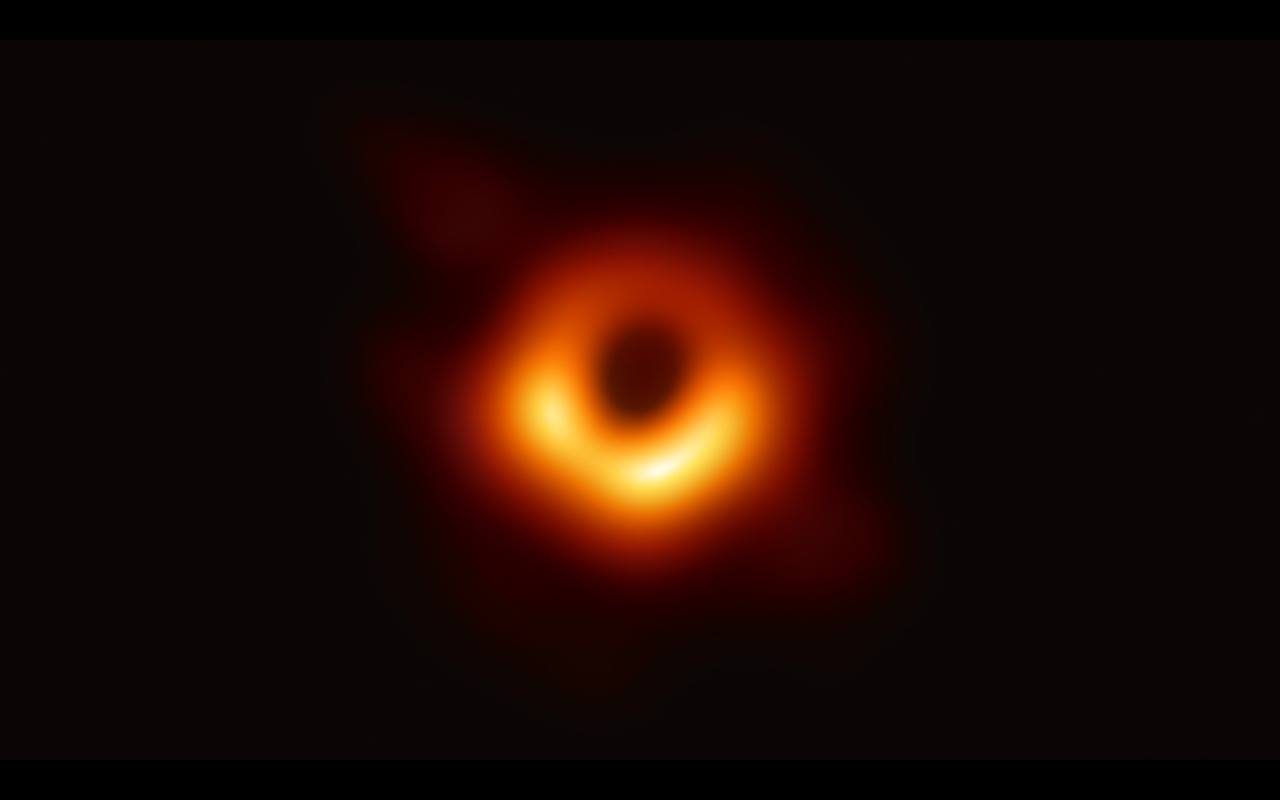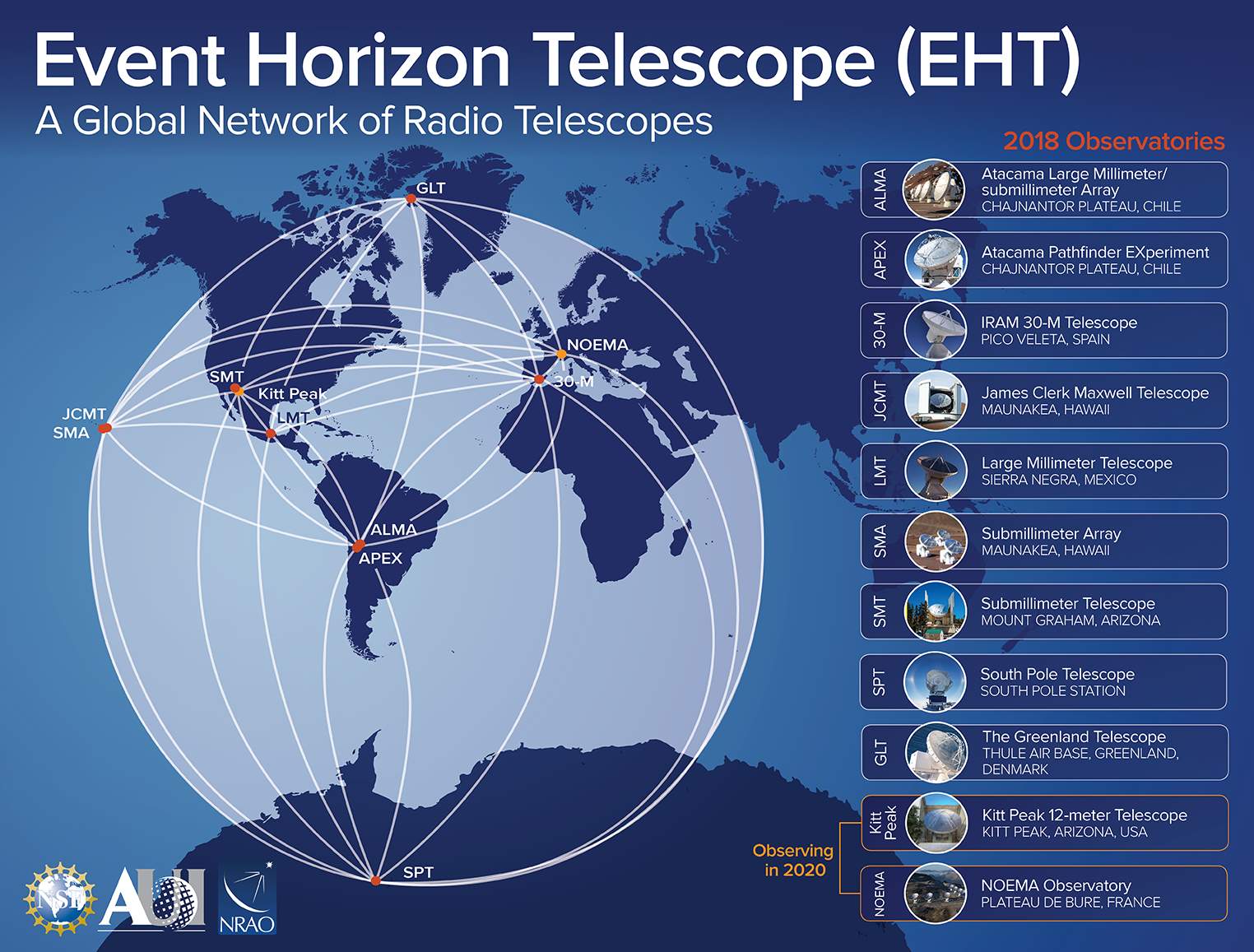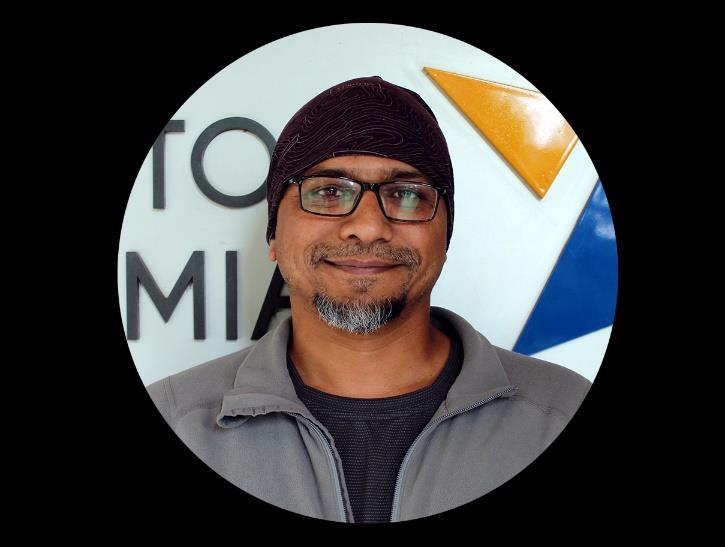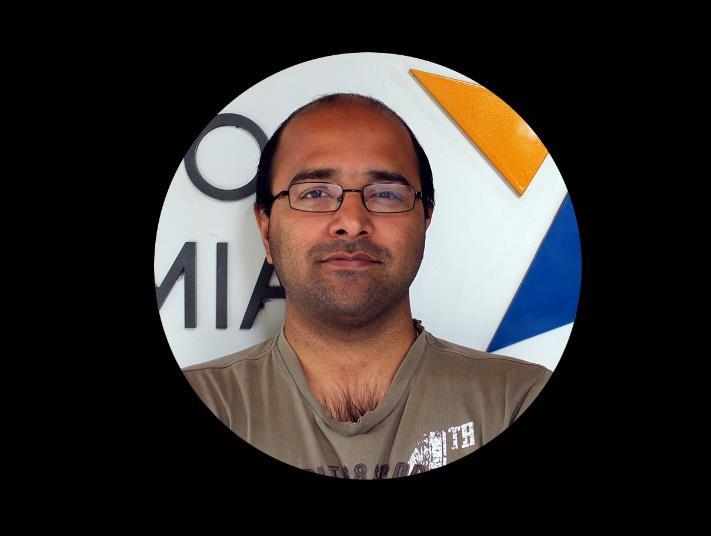
Team of Astronomers Captures the First-Ever Picture of a Black Hole
The Event Horizon Telescope (EHT), a network of eight telescopes located around the world and formed through an international collaboration, was designed to capture images of a black hole. On 10 April 2019, six coordinated press conferences worldwide revealed, as announced by EHT researchers, the first direct evidence of a supermassive black hole and its shadow.
This revolutionary advance was announced in a series of six scientific articles published in a special issue of the The Astrophysical Journal Letters. The image reveals the black hole at the centre of Messier 87 (M87) [1], a massive galaxy in the nerby Virgo galaxy cluster. This black hole is located 55 million light-years from Earth and it has a mass 6.5 billion times that of the Sun. [2].
The EHT links telescopes located worldwide to form an unprecedented Earth-sized virtual telescope. [3]. For scientists, it offers a new way to study the most extreme objects in the universe, as predicted by Einstein's general theory of relativity, in the centenary year of the historic 1919 experiment that first confirmed the theory[4].
"We have taken the first ever photograph of a black hole", declared Sheperd S. Doeleman, Director of the Event Horizon Telescope (EHT) at the Harvard–Smithsonian Center for Astrophysics "It is an extraordinary scientific achievement, accomplished by a team of over 200 researchers"
Black holes are extraordinary cosmic objects with enormous mass yet extremely compact dimensions. Their presence affects their surroundings in extreme ways, distorting space-time and overheating any surrounding material.

"If it is within a bright region, like a disc of gas shining intensely, we can expect that a black hole creates a dark region similar to a shadow, something predicted by Einstein’s general theory of relativity that we have never seen before", explained Heino Falcke, the Chair of the EHT Science Council, at University of Radboud in the Netherlands. "This shadow, caused by the gravitational bending and the light captured by the event horizon, reveals a lot about the nature of these fascinating objects and has allowed us to measure the large mass of the black hole in M87."
Using multiple calibration and imaging methods, a ring-shaped structure with a dark region at the centre - the black hole's shadow - has been discovered, which was consistently detected across several independent observations conducted by the EHT.
"When we were sure that we had captured the image of the shadow, we could compare our observations against a large library of computational models that include the physics of curved space, superheated matter and intense magnetic fields. Many of the structures in the image match the theoretical predictions surprisingly well", commented Paul T.P. Ho, member of the EHT Science Council and Director of the East Asian Observatory. "This allows us to be confident in the interpretation of our observations, including the estimated mass of the black hole".
Over 200 researchers contributed to this work. Among them were Drs. Neil Nagar and Venkatessh Ramakrishnan - an academic and a postdoctoral researcher, respectively - both from the Department of Astronomy at the University of Concepcion. Their contribution made the university the only Chilean institution to participate in this astronomical breakthrough. "This discovery is one of the most precise tests that Einstein's general theory of relativity has faced, which is now approximately 100 years old. This is because the discovery lies at the limit of strong gravity (event horizon, very close to a black hole), which makes it easier to detect small differences between observation and theory; and the theory has survived… for now", commented Dr. Neil Nagar.
"The image we captured is the strongest and most direct evidence that confirms the existence of supermassive black holes (masses millions of times greater than that of the Sun). Previously, the confirmation of the existence of black holes with masses ten times that of the Sun was through the detection of gravitational waves", noted Dr. Nagar.
"Confronting theory with observation is always a crucial moment for a theorist. It was a source of pride and relief to have concluded that observations matched the prediction so well", added Luciano Rezzola, member of the EHT Council from University of Goethe, Germany.
The creation of the EHT was a formidable challenge. It required the upgrading and connection of a global network of eight telescopes, located in multiple high-altitude locations. Among these locations, the volcanoes in Hawaii and Mexico, the mountains in both Arizona and Sierra Nevada, the Atacama Desert in Chile, and Antarctica.
The observations conducted by the EHT employ a technique called Very-Long-Baseline Interferometry (VLBI) that synchronises telescopes located in facilities around the world, and exploits the Earth's rotation to create a large Earth-sized telescope that can observe at a wavelength of 1.3 mm. This technique allows the EHT to achieve an angular resolution of 20 microarcseconds (fine enough to read a newspaper in New York from a coffee shop in Paris) [5].
The telescopes that contributed to this achievement are ALMA and APEX, both in Chile, the 30-metre IRAM telescope, the James Clerk Maxwell Telescope, the Large Millimeter Telescope Alfonso Serrano, the Submillimetre Array, the Submillimetre Telescope, and the South Pole Telescope[6]. The raw data obtained from these telescopes totalled petabytes (1 petabyte = 1.024 terabytes), and were processed and combined by highly specialised supercomputers located at the Max Planck Institute for Radio Astronomy and the Haystack Observatory at MIT.
"For ESO, it was a source of satisfaction to be able to have contributed significantly to this result through its European leadership and its fundamental role in two telescopes that are part of EHT, ALMA and APEX, located in Chile" [7], said Xavier Barcons, Director General of ESO. "ALMA is the most sensitive facility in the EHT, its 66 high-precision antennas were vital in making the EHT a success".
The construction of the EHT and the observations announced today represent the culmination of decades of theoretical, technical, and observational work. This example of teamwork required the close collaboration among researchers from around the world. Thirteen institutions worked together to create the EHT, using both pre-existing infrastructure and support from many institutions. The key funding was provided by the National Science Foundation (NSF), the European Research Council (ERC), and funding agencies in East Asia [8].
"We have achieved something that, just a generation ago, seemed impossible", concluded Doeleman. "The revolutionary advances in technology, the links between the world’s leading radio observatories, and the innovative algorithms, all of these together have opened an entirely new window for studying black holes and the event horizon".
Notes
[1] The shadow of a black hole is the closest we can come to capturing the image of a black hole, an entirely dark object from which light cannot escape. The boundary of a black hole - the event horizon, from which the EHT takes its name - is approximately 2.5 times smaller than the projected shadow and is almost 40 billion kilometres.
[2] Supermassive black holes are relatively small objects, which has made it impossible to observe them directly until now. Given that the size of the event horizon is proportional to its mass, the more massive it is, the bigger its shadow becomes. Thanks to its large mass and its relative proximity, it was predicted that the black hole in M87 would be one of the most visible from Earth, making it the perfect target for the EHT.
[3] Although the telescopes are not physically connected, they are able to synchronise their data using atomic clocks — hydrogen maser, which precisely measure the time of the observations. These observations were taken at a wavelength of 1.3 mm during a worldwide campaign conducted in 2017. Each telescope produced a large amount of data - approximately 350 terabytes per day - which was stored in high-performance helium hard drives. This data was sent to specialised supercomputers - known as correlators - located at theMax Planck Institute for Radio Astronomy and the MIT Haystack Observatory , where they were combined. Then, using novel computational tools developed by the collaboration, the data was carefully converted into an image.
[4] A hundred years ago, two expeditions were sent to Principe (off Africa's coast) and Sobral (Brazil) to observe the solar eclipse in 1919. The aim was to test general relativity by observing whether starlight would bend around the edges of the Sun as predicted by Einstein. Inspired by these observations, the EHT sent members to some of these remote and high-altitude radio astronomy facilities to test once again our understanding of gravity.
[5] The participation of the East Asian Observatory in the EHT represents also the involvement of many regions across Asia, including China, Japan, Korea, Taiwan, Vietnam, Thailand, Malaysia, India and Indonesia.
[6] Future EHT observations will benefit from substantially higher sensitivity thanks to the participation of the IRAM NOEMA Observatory, Greenland Telescope, and the Kitt Peak Telescope.
[7] ALMA (Atacama Large Millimeter/submillimeter Array) is an international astronomical facility established through a collaboration between the European Southern Observatory (ESO, Europe), the National Science Foundation (NSF, USA), the National Institutes of Natural Sciences (NINS, Japan), together with the National Research Council of Canada, the Ministry of Science and Technology (MOST, Taiwan), the Academia Sinica Institute of Astronomy and Astrophysics (ASIAA, Taiwan), the Korea Astronomy and Space Science Institute (KASI, Korea), in cooperation with the Republic of Chile. Operations of APEX are managed by ESO; the 30-metre Telescope is operated by IRAM (partners of IRAM are MPG in Germany, CNRS in France, and IGN in Spain); the James Clerk Maxwell Telescope is managed by EAO; the Large Millimeter Telescope Alfonso Serrano is operated by INAOE and the UMass; the Submillimetre Array is operated by SAO and ASIAA; and the Submillimetre Telescope is managed by ARO (Arizona Radio Observatory). Operations of the South Pole Telescope are managed by the University of Chicago and is equipped with specialised instrumentation for the ETH provided by the University of Arizona .
[8] The BlackHoleCam project is funded by the EU to capture images, make measurements, and understand black holes. The main aim of BlackHoleCam and the Event Horizon Telescope (EHT) is to capture the first image of a billion-solar-mass black hole located in the nearby galaxy M87, as well as its smaller counterpart, Sagittarius A*, the supermassive black hole located at the centre of our Milky Way. This allows us to measure with extreme precision the spacetime deformation caused by a black hole.
He obtained his PhD in Astronomy from the University of Maryland, College Park, USA, in 2000, and earned his Bachelor's degree in Electrical Engineering and Master's degree in Mathematics from the Birla Institute of Technology and Science, Pilani, India, in 1993. His research focuses on active galaxies, supermassive black holes, galaxy kinematics, and ultra-high-energy cosmic rays.
He has been working with the EHT since 2010. Currently, he is involved in sub-groups focusing on active galaxies, calibration of ALMA data collected during EHT observations. His research group is leading projects aimed at measuring the mass of supermassive black holes (including M87) utilising ALMA and VLT, and at identifying additional nearby galaxies for future EHT observations.
Currently, he has been teaching in the Department of Astronomy at the University of Concepción since 2004.
Specific roles in ALMA and EHT:
- ALMA Phasing Project (APP) and APEX: Nagar has participated in the APP since 2009 and contributed funding equivalent to approximately five years of postdoctoral funding and around $80K US in equipment, as well as to the maser installation and setting up the APP. Postdoctoral researchers Nestor Lasso collaborated in programming the PIC cards (inserted in the correlator), while the postdoctoral researchers Jay Blanchard played an important role in the installation and bringing into service. Drs. Nagar and Blanchard have also been heavily involved in most of the efforts to commissioning and conduct APEX observations from 2014 to the present.
- EHT: Dr. Nagar has participated since 2009, starting with the APP. The University of Concepcion has been an EHT member since its establishment. Dr. Nagar is co-coordinator of the "AGN and other non-horizon sciences" group of the EHT. His main contributions include the analysis of ALMA data sets, support during APEX observations, time proposals (e.g., Co-PI of the proposals for M87 and SgrA* at ALMA) and funds to mainly postdoctoral researchers, development of a sample of nearby galaxies beyond M87 and SgrA* for EHT observations, and the determination of black hole masses for M87 and other future EHT targets.
He obtained his PhD in Space Science and Technology from Aalto University, Finland, in 2016, and holds a Master's degree in Astronomy from University of Turku, Finland. His research focuses on active galaxies, particularly their variability and kinematics. He has worked with the EHT since 2016 and is currently working in the sub-groups of active galaxies, image reconstruction algorithms, and data calibration, supporting EHT testing and observations using the APEX telescope. Moreover, he dedicates part of his work to projects aimed at identifying nearby galaxies for future EHT observations.
He has been working in his postdoctoral research at the Department of Astronomy since 2016. Dr. Venkatessh was hired through the ALMA-CONICYT Postdoctoral Programme at University of Concepcion to support the scientific use of EHT. He has made significant contributions to the EHT Imaging Group, having participated in all major imaging efforts of M87, and is also dedicated to obtaining images of other EHT targets. His work includes continuum and spectral line imaging data of ALMA from the EHT, contributing to improved calibration and collecting a larger sample of nearby galaxies for future EHT observations. In addition, he has been involved in all EHT runs - system set up and observations - at APEX.
Additional information
This research has been published as a series of six articles in a special issue of The Astrophysical Journal Letters.
The EHT collaboration involves over 200 researchers from Africa, Asia, Europe, North and South America. This international collaboration is working to capture the first and most detailed images of black holes thanks to the creation of a virtual telescope the size of the Earth. Supported by significant international funding, The EHT combines pre-existing telescopes equipped with new systems, effectively creating a new instrument with greater angular resolution than ever before.
The single telescopes involved are: ALMA, APEX, 30-metre IRAM Telescope, the NOEMA-IRAM Observatory, the James Clerk Maxwell Telescope, the Large Millimeter Telescope, the Submillimeter Telescope, the South Pole Telescope, the Kitt Peak National Observatory, and the Greenland Telescope.
The EHT Consortium is composed of 13 institutes: the Seneca Academy Institute of Astronomy and Astrophysics, the University of Arizona, the University of Chicago, the East Asian Observatory, the Goethe University Frankfurt, the Institut de Radioastronomie Millimétrique, the Large Millimeter Telescope, the Max Planck Institute for Radio Astronomy, the MIT Haystack Observatory, the National Astronomical Observatory of Japan, the Perimeter Institute for Theoretical Physics, the Radboud University, and the Smithsonian Astrophysical Observatory.
The European Southern Observatory is the leading intergovernmental astronomy organisation in Europe and the most productive astronomical observatory in the world. It has sixteen member countries: Germany, Austria, Belgium, Denmark, Spain, Finland, France, Ireland, Italy, the Netherlands, Poland, Portugal, United Kingdom, Czech Republic, Switzerland, together with the host country, Chile, and the strategic partner, Australia. The institution develops an ambitious programme centred on the design, construction and operation of powerful facilities for ground observations that enables the astronomers to make significant scientific discoveries. It also plays an important role in promoting and fostering cooperation in astronomical observations. In Chile, it operates three unique observing sites in the world: La Silla, Paranal and Chajnantor. In Paranal, ESO operates the Very Large Telescope together with the Very Large Telescope Interferometer, the most advanced in the world, as well as two survey telescopes: the Visible and Infrared Survey Telescope for Astronomy, which observes in the infrared, and the VLT Survey Telescope, which surveys in visible light. In this location, ESO will host and operate the Cherenkov Telescope Array, the largest and most sensitive gamma-ray observatory in the world. ESO is also a partner in two facilities in Chajnantor, APEX, and ALMA, currently the largest operational astronomical project in the world. Finally, at Cerro Armazones, close to Paranal, ESO is building the Extremely Large Telescope, a 39-metre telescope, which is said to be "the world’s biggest eye on the sky".
Celeste Burgos Badal
Astronomy Department Communications







